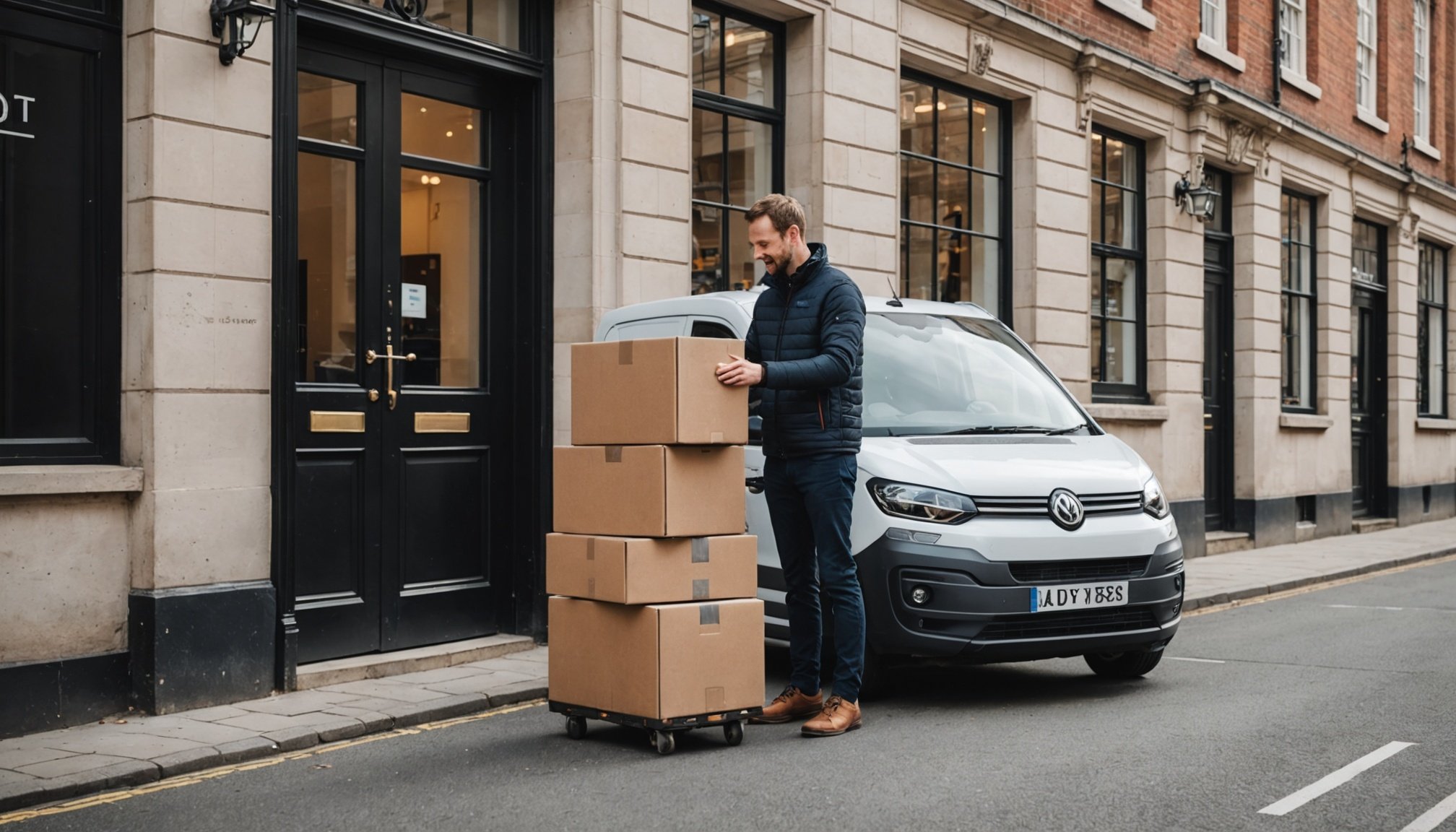Unlocking Last-Mile Delivery Success: Innovative Strategies for Boosting E-Commerce Efficiency in the UK
In the ever-evolving landscape of e-commerce, the last mile of delivery has emerged as a critical component that can make or break the customer experience. As online shopping continues to soar, businesses in the UK are under increasing pressure to deliver goods efficiently, reliably, and cost-effectively. Here’s a deep dive into the innovative strategies that are transforming last-mile delivery and boosting e-commerce efficiency.
Understanding the Last Mile Challenge
The last mile, the final leg of the delivery process, is often the most complex and costly part of the supply chain. It involves getting the product from the distribution center to the customer’s doorstep, a journey fraught with logistical challenges.
Also to discover : Transforming workplace safety with cutting-edge technology
“The last mile is where the rubber meets the road,” says Nick Waters, the new CEO for Making Science Group in the UK, Europe North, and Central. “It’s where consumer preferences and expectations are met or missed. Companies need to be innovative and adaptable to succeed in this space.”[1]
Leveraging Technology for Real-Time Tracking and Optimization
Technology is at the forefront of last-mile delivery innovations. Real-time tracking, route optimization, and predictive analytics are some of the tools that companies are using to streamline their delivery processes.
Have you seen this : Marking buoys in saudi arabia: ensuring safe navigation
- Real-Time Tracking: Companies like nShift are integrating real-time tracking into their logistics solutions. This allows customers to monitor their packages in real time, enhancing customer satisfaction and reducing anxiety about delivery times[1].
- Route Optimization: Advanced algorithms can optimize delivery routes, reducing fuel consumption and lowering emissions. This not only cuts costs but also contributes to a more sustainable logistics operation.
- Predictive Analytics: By analyzing historical data and consumer behavior, companies can predict demand and optimize their delivery schedules accordingly. For instance, Elida Beauty has partnered with Kinaxis to modernize its supply chain operations, including predictive analytics to better manage inventory and shipping[1].
Diversifying Delivery Options
Consumers today demand flexibility and convenience in their delivery options. Here are some innovative strategies companies are adopting:
Delivery Lockers and Parcel Lockers
Delivery lockers and parcel lockers are becoming increasingly popular. These secure, self-service kiosks allow customers to pick up their packages at their convenience, reducing the need for multiple delivery attempts.
| Delivery Method | Benefits | Drawbacks |
|---|---|---|
| Home Delivery | Convenient | Multiple attempts may be needed |
| Delivery Lockers | Flexible pickup times | Limited locations |
| Parcel Lockers | Secure and self-service | Requires initial setup |
| Click and Collect | Immediate pickup | Limited to store hours |
Same-Day and Next-Day Delivery
Same-day and next-day delivery options are highly valued by consumers. Companies are investing in logistics to make these options more viable.
“73% of consumers are looking for a unified shopping experience, which includes fast and reliable delivery options,” notes a report by nShift. “To achieve this, businesses need to integrate their e-commerce, in-store sales, and delivery capabilities more closely”[1].
Enhancing Customer Experience
Customer satisfaction is the ultimate goal of any delivery strategy. Here are some ways companies are enhancing the customer experience:
Personalized Delivery Services
Companies are offering personalized delivery services that cater to individual consumer preferences. For example, some companies allow customers to choose their delivery time slots or specify special instructions for delivery.
Transparent Communication
Keeping customers informed throughout the delivery process is crucial. Real-time updates via SMS, email, or app notifications can significantly improve customer satisfaction.
“Transparent communication is key to building trust with customers,” says an industry expert. “When customers know exactly where their package is and when it will arrive, they feel more in control and satisfied with the service.”
Reducing Costs and Environmental Impact
Last-mile delivery can be costly and environmentally detrimental if not managed efficiently. Here are some strategies to reduce costs and environmental impact:
Electric and Hybrid Vehicles
Many companies are transitioning to electric or hybrid vehicles for their delivery fleets. This not only reduces fuel costs but also lowers emissions, contributing to a more sustainable logistics operation.
Consolidated Shipping
Consolidating shipments can reduce the number of vehicles on the road, thereby lowering costs and environmental impact. This involves grouping multiple packages into a single shipment, which can be particularly effective for businesses with high volume orders.
Building a Resilient Supply Chain
A resilient supply chain is essential for maintaining efficiency in last-mile delivery. Here are some strategies to build a robust supply chain:
Advanced Logistics Systems
Implementing advanced logistics systems that integrate with global supply chain networks is crucial. These systems should be capable of managing complexities such as customs procedures and real-time updates.
“Using cloud-based logistics solutions can ensure accessibility and facilitate collaboration across different geographical areas,” advises a guide on creating a transport business in Italy. “Incorporating advanced analytics for data-driven decision-making and optimizing supply chain performance is also essential”[2].
Risk Management and Insurance Strategies
Solid risk management and insurance strategies are vital for any logistics operation. This includes evaluating potential risks, structuring insurance policies to cover identified risks, and continuously analyzing and adapting these strategies over time.
“Risk management is a cornerstone of any successful logistics and transport business,” emphasizes the guide. “It helps in mitigating potential risks and ensuring smooth operations”[2].
Practical Insights and Actionable Advice
For businesses looking to enhance their last-mile delivery efficiency, here are some practical insights and actionable advice:
- Invest in Technology: Leverage real-time tracking, route optimization, and predictive analytics to streamline your delivery process.
- Diversify Delivery Options: Offer flexible delivery options like delivery lockers, parcel lockers, and same-day delivery to cater to different consumer preferences.
- Enhance Customer Communication: Keep customers informed throughout the delivery process to improve customer satisfaction.
- Reduce Environmental Impact: Transition to electric or hybrid vehicles and consolidate shipments to lower costs and emissions.
- Build a Resilient Supply Chain: Implement advanced logistics systems and robust risk management strategies to ensure smooth operations.
The last mile of delivery is no longer just a logistical challenge; it’s a critical component of the customer experience. By leveraging technology, diversifying delivery options, enhancing customer communication, reducing costs and environmental impact, and building a resilient supply chain, businesses in the UK can unlock last-mile delivery success.
As the e-commerce landscape continues to evolve, companies that adapt and innovate will be the ones that thrive. By focusing on customer satisfaction, efficiency, and sustainability, businesses can turn the last mile into a competitive advantage rather than a challenge.
In the words of Nick Waters, “Innovation in last-mile delivery is not just about technology; it’s about understanding consumer preferences and adapting to meet those needs. Companies that do this well will be the ones that succeed in the long run.”











